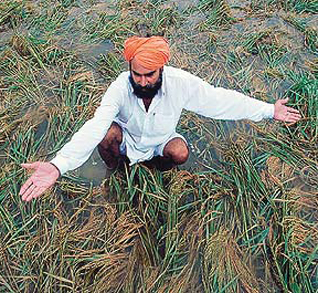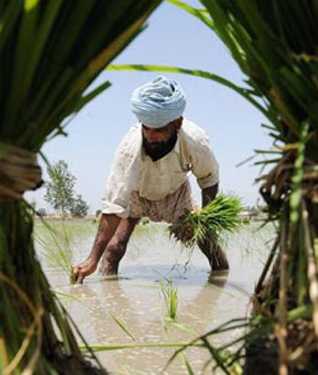1984
River Water Rights & Ecological Collapse
The State of Punjab
Part III
GUNISHA KAUR
Punjab has been a hotspot of human rights violations and activism since the birth of the Indian nation in 1947. The history of human rights abuses in the state has contributed significantly to the present economic, environmental and medical crisis in Punjab.
In this multi-part series, we explore the emergent issues in the state, with a focus on farmer suicides, female feticide and infanticide, ecological damage, river water rights, rising rates of diseases, mental health, and drug and alcohol abuse.
The path to agricultural success in Punjab has been littered with obstacles.
The first factor that restricted the growth of Punjab was the Punjab Reorganization Act of 1966, which divided the state into three parts and apportioned two-thirds of the geographical area to other states.
The second major hindrance to agricultural triumph was the redistribution of 75% of Punjab's river water to other regions in 1976. The federal government legislated that Punjab relinquish a significant portion of its water to the neighboring regions of Delhi, Haryana, and Rajasthan to help boost their agricultural economies.
The third impediment was the implementation of the unsustainable Green Revolution technology.
In addition to the over-exploitation of environmental
resources caused by the Green Revolution, the government’s stripping of
Punjab’s land and water combined with the Sikh community’s demanding of
the state’s constitutional rights have been the predominant foundations
for economic, environmental, political, and social strife in the Punjab
region over the past five decades.
Punjabis reacted strongly to the Reorganization Act of 1966. The greatest opposition emerged in 1976 as a response to the redistribution of 75% of Punjab's river water to other regions under Section 78 of the Act, vis-a-vis the Satluj-Yamuna Link Canal (SYL). Punjab filed a suit with the Supreme Court contesting the legality of the act, and the Shiromani Akali Dal demanded redress as outlined in the Anandpur Sahib Resolution, and began peacefully protesting the redistribution of water.
The Shiromani Akali Dal organized campaigns, including marches known as the rail roko (stop the trains), rasta roko (block the roads), and the nahar roko (stop the river).
The issue related to Punjab's water consumption patterns. To properly irrigate its 10.5 million acres of cultivatable land, Punjab requires a minimum water flow of 52.5 MAF. The combined effect of Partition, the Punjab Reorganization Act, and subsequent water-stripping legislation by the government has resulted in a mere 3.5 MAF available to Punjab’s farmers - or enough water to properly cultivate only 0.7 million acres.
These astounding data
indicate that, given current patterns of water redistribution, only 6%
of Punjab’s land can be properly irrigated. This figure is significant
considering that more than 83% of Punjab's land is currently dedicated
to agriculture and that a vast majority of agriculture is now rooted in
Green Revolution technology.
The Green Revolution follows a model of high input and high output and relies heavily on High Yield Variety seeds, which require the intensive use of fertilizers, pesticides, and water. The widespread exploitation of underwater aquifers via tube wells to supplement the deficient canal water supply has resulted in a rapid drop in the water table throughout Punjab, currently at a rate of 100 cm per year (a drastic shift from the 18 cm per year fall during the 1980s).
These figures indicate that current patterns of water use in the state are grossly unsustainable; in fact, experts estimate that if current patterns do not change, Punjab's entire water supply will be depleted within 15 to 20 years.
Of the state's 137 blocks, 103 have already been declared by the government as overexploited.
Whereas a majority of the state is facing the problem of overexploitation of water resources, the southwestern districts of Punjab are encountering an entirely different problem: waterlogging and resultant soil salinity, though this issue is beyond the scope of this article.
Green Revolution technology use for national food security has led to the exclusive dual rice-wheat rotation and a 100% utilization of High Yield Variety seeds. This exclusive High Yield Variety, two-crop rotation at the cost of the traditionally diverse Punjabi crop rotation has contributed significantly to the damage of indigenous biodiversity and immense soil erosion. Soil fertility at both macro levels (nitrogen, phosphorous, and potassium) and micro levels (zinc, iron and manganese) has become so deficient that the use of manufactured fertilizers has increased more than eightfold since the 1970s.
Further, the
marginalization of diversity is high-stakes ecological gambling – if the
right insect or strain of disease arises, the genetically homogeneous
High Yield Variety rice and wheat crops would likely be wiped out. To
sustain genetically weak High Yield Variety crops, pesticide consumption
has more than doubled from the 1980s to 1990s. The shift from
traditional agriculture to technologically advanced farming has also led
to the replacement of manual farm labor by combines and tractors,
resulting in a significant increase in air pollution.
The Punjab Reorganization Act, federal redistribution of river water in 1976, and the implementation of the Green Revolution have led to an impending ecological collapse in Punjab.
The Anandpur Sahib Resolution and associated Akali Dal agitations such as the rasta roko, nahar roko, and kam roko (work stoppage) campaigns protested the illegal stripping of Punjab's water, and Punjabis are still awaiting recognition and resolution of the major issues by the federal government.
Punjab will continue to be a problematic region, in the political, economic, and environmental arenas, until the key issues outlined in the Anandpur Sahib Resolution are acknowledged and Punjab is given back its river waters rights as guaranteed by the Indian constitution.
[The author is a human rights activist and a physician at Cornell University in New York City. Her research focuses on chronic pain management in survivors of torture, and she has written extensively on human rights violations in India. Her first book, entitled "Lost in History: 1984 Reconstructed" - [http://www.panjabmall.com/storeproduct508.aspx], documents the violence in Punjab that took place in the 1980s and 1990s. The articles in this series draw from her forthcoming book, which discusses the current economic, environmental, and health crisis in Punjab.]
Parts I & II in this series can be accessed from the "1984" section on this site.
May 21, 2012
Conversation about this article
1: Sunny Grewal (Abbotsford, British Columbia, Canada), May 21, 2012, 6:10 PM.
Why is the burden of food security placed squarely on Punjab's shoulders? Punjabis may be the best farmers in the world, but that is no reason why our homeland should be slowly transformed into a wasteland. Is the rest of India really that incapable that they are unable to match the output of Punjab? If the Indian government actually put in a half-hearted attempt to raise the quality of food production in other states, then maybe millions of Indians wouldn't go hungry every night.
2: Hardeep Kaur (Abbotsford, British Columbia, Canada), May 21, 2012, 6:42 PM.
Here is a great website started by BC youth that provides further reading material on this topic: http://www.savepanjab.org/




